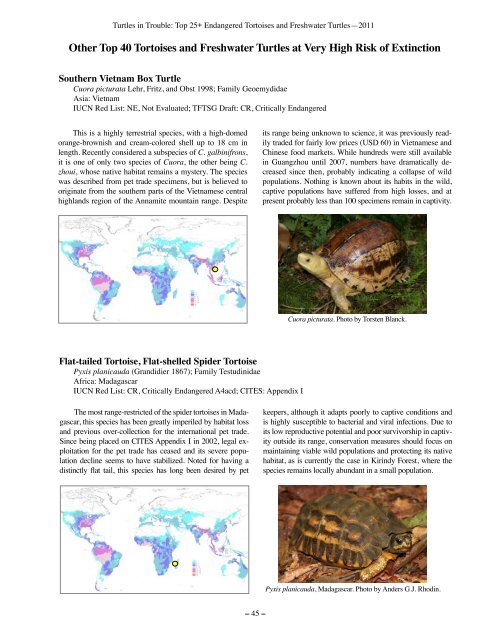Turtles in Trouble: The World's 25+ Most Endangered - Wildlife ...
Turtles in Trouble: The World's 25+ Most Endangered - Wildlife ...
Turtles in Trouble: The World's 25+ Most Endangered - Wildlife ...
- No tags were found...
Create successful ePaper yourself
Turn your PDF publications into a flip-book with our unique Google optimized e-Paper software.
<strong>Turtles</strong> <strong>in</strong> <strong>Trouble</strong>: Top <strong>25+</strong> <strong>Endangered</strong> Tortoises and Freshwater <strong>Turtles</strong>—2011Other Top 40 Tortoises and Freshwater <strong>Turtles</strong> at Very High Risk of Ext<strong>in</strong>ctionSouthern Vietnam Box TurtleCuora picturata Lehr, Fritz, and Obst 1998; Family GeoemydidaeAsia: VietnamIUCN Red List: NE, Not Evaluated; TFTSG Draft: CR, Critically <strong>Endangered</strong>This is a highly terrestrial species, with a high-domedorange-brownish and cream-colored shell up to 18 cm <strong>in</strong>length. Recently considered a subspecies of C. galb<strong>in</strong>ifrons,it is one of only two species of Cuora, the other be<strong>in</strong>g C.zhoui, whose native habitat rema<strong>in</strong>s a mystery. <strong>The</strong> specieswas described from pet trade specimens, but is believed toorig<strong>in</strong>ate from the southern parts of the Vietnamese centralhighlands region of the Annamite mounta<strong>in</strong> range. Despiteits range be<strong>in</strong>g unknown to science, it was previously readilytraded for fairly low prices (USD 60) <strong>in</strong> Vietnamese andCh<strong>in</strong>ese food markets. While hundreds were still available<strong>in</strong> Guangzhou until 2007, numbers have dramatically decreaseds<strong>in</strong>ce then, probably <strong>in</strong>dicat<strong>in</strong>g a collapse of wildpopulations. Noth<strong>in</strong>g is known about its habits <strong>in</strong> the wild,captive populations have suffered from high losses, and atpresent probably less than 100 specimens rema<strong>in</strong> <strong>in</strong> captivity.Cuora picturata. Photo by Torsten Blanck.Flat-tailed Tortoise, Flat-shelled Spider TortoisePyxis planicauda (Grandidier 1867); Family Testud<strong>in</strong>idaeAfrica: MadagascarIUCN Red List: CR, Critically <strong>Endangered</strong> A4acd; CITES: Appendix I<strong>The</strong> most range-restricted of the spider tortoises <strong>in</strong> Madagascar,this species has been greatly imperiled by habitat lossand previous over-collection for the <strong>in</strong>ternational pet trade.S<strong>in</strong>ce be<strong>in</strong>g placed on CITES Appendix I <strong>in</strong> 2002, legal exploitationfor the pet trade has ceased and its severe populationdecl<strong>in</strong>e seems to have stabilized. Noted for hav<strong>in</strong>g adist<strong>in</strong>ctly flat tail, this species has long been desired by petkeepers, although it adapts poorly to captive conditions andis highly susceptible to bacterial and viral <strong>in</strong>fections. Due toits low reproductive potential and poor survivorship <strong>in</strong> captivityoutside its range, conservation measures should focus onma<strong>in</strong>ta<strong>in</strong><strong>in</strong>g viable wild populations and protect<strong>in</strong>g its nativehabitat, as is currently the case <strong>in</strong> Kir<strong>in</strong>dy Forest, where thespecies rema<strong>in</strong>s locally abundant <strong>in</strong> a small population.Pyxis planicauda, Madagascar. Photo by Anders G.J. Rhod<strong>in</strong>.– 45 –







![RaLand / SeaScape [PDF] - Wildlife Conservation Society](https://img.yumpu.com/49974326/1/190x245/raland-seascape-pdf-wildlife-conservation-society.jpg?quality=85)








